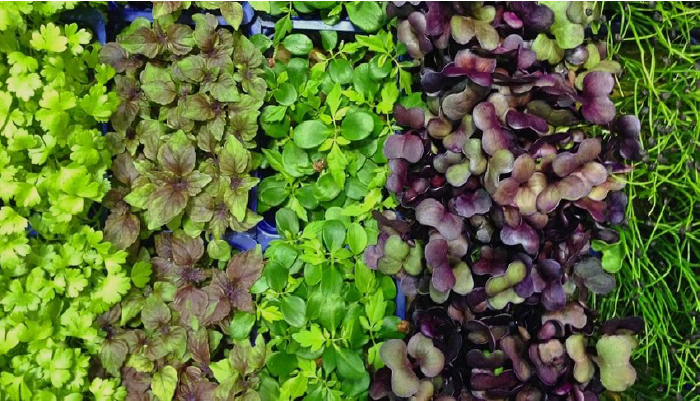You’ve heard the saying “big things come in small packages” right? Well, true that is, when it comes to microgreens. These little bits of vegetable confetti may be pint sized, but they pack a powerful punch.
What exactly are microgreens? They’re a vegetable, a teensy-eensy vegetable. In the “line up according to your height” veggie world, it goes like this. First there are “greens”, normal sized and full grown. Then more petite, are “baby greens”, smaller in size, more delicate and tender. Tinier yet, we have “microgreens”, I call them the “tween greens”. Then last and the most diminutive are “sprouts”.
It all starts out with a seed. Add water, give it a few days and you get sprouts. These have two leaves, called embryonic leaves (seed leaves), a stem and a root. They are harvested in about a week and you eat them root and all. If you plant them, these little elves can get a teensy bit older. They will pop out two more “true leaves”. By the time they get about four leaves and two inches tall they can be harvested by cutting with a scissors at the base. Then voila! We have the mighty microgreen.
At Salty’s Seafood Grills, our chef’s use them to add colorful flair and a pop of flavor. This month you can find them in our delicious wild one’s festival dish, Salmon BLATA Salad.
The interesting thing about microgreens is that although they are small in size, they are huge in every other way. First the flavor is amazing. It’s way more concentrated than a full grown green. When I say a full grown green, I don’t actually mean it has to be green. Cauliflower, endive, radicchio, swiss chard, beet, carrot, garlic and fennel all can be found as microgreens, yielding all kinds of beautiful colors. The other huge thing about microgreens is their powerful nutrient content. Studies have shown that in general microgreens have five times the nutrient content as their full-grown plant. If you think about it, it makes sense. All the potential of that plant is found in the seed. When the seed sprouts it brings all of that stored power into action, and it’s like a massive microburst of flavor and nutrition. They are super rich in polyphenols, which are excellent antioxidants. A diet rich in antioxidants can help lower the risk of heart disease, Alzheimer’s, diabetes and cancer. Boom!
Remember microgreens are always eaten fresh. To learn some big ideas about this little vegetable, check out what our Chef Jeremy has to say.
Not a sprout and not full-grown mighty microgreens hold their own!

